In the state of Illinois, during the arrival of warblers in spring and summer, it is common to see yellow birds, but during the winter season, the American Goldfinch is the most frequently spotted yellow bird.
To assist you in identifying the yellow birds you have encountered in Illinois, this guide provides pictures, identification information, song recordings, as well as details about their migration patterns.
The majority of yellow birds found in Illinois are warblers, orioles, or tanagers, and sometimes female birds of these species look markedly different from the males.
By utilizing the comprehensive information provided in this guide, identifying yellow birds will become much easier. The yellow birds listed below are arranged in order of their common occurrence in Illinois during spring and summer, based on ebird checklists for May and June.
Yellow birds found in Illinois throughout the year: American Goldfinch
Yellow birds found in Illinois during the summer: Common Yellowthroat, Cedar Waxwing, Baltimore Oriole, Eastern Meadowlark, Yellow Warbler, Dickcissel, Scarlet Tanager, Orchard Oriole, Yellow-throated Vireo, White-eyed Vireo, Summer Tanager, Prothonotary Warbler, Yellow-throated Warbler, Hooded Warbler, Yellow-headed Blackbird, Prairie Warbler, Western Meadowlark, Western Kingbird
Yellow birds found in Illinois during the winter: Evening Grosbeak
Yellow birds found in Illinois during migration: Yellow-rumped Warbler, Palm Warbler, American Redstart, Magnolia Warbler, Nashville Warbler, Black-throated Green Warbler, Wilson’s Warbler, Orange-crowned Warbler, Cape May Warbler, Canada Warbler, Pine Warbler, Blue-winged Warbler
Therefore, continue reading to identify the yellow birds you have encountered.
1. American Goldfinch
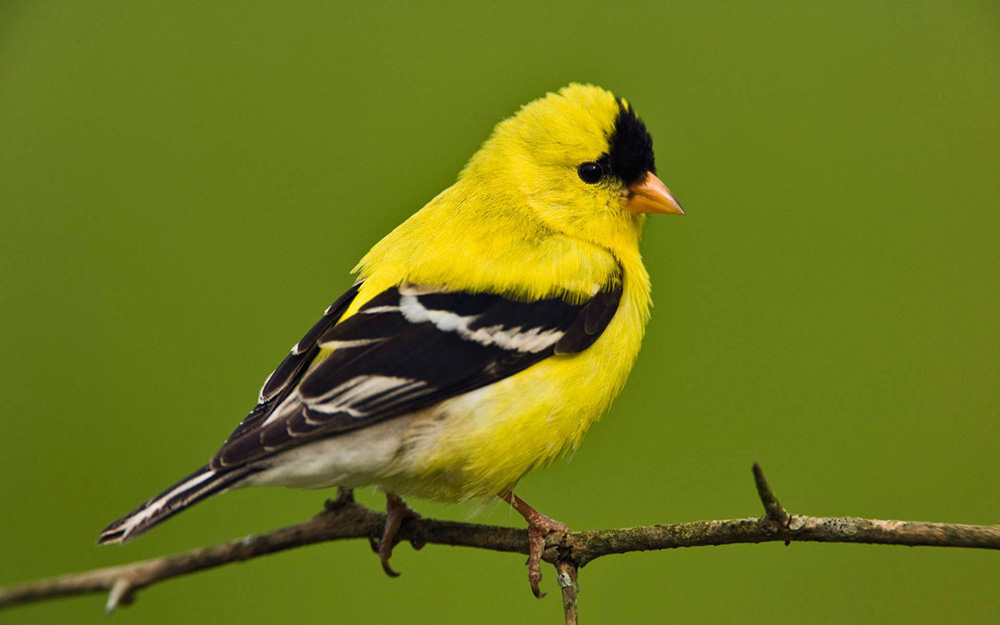
For identification, the American Goldfinch is a yellow bird that can be found in Illinois all year round, with higher numbers during the breeding season from July to October. This species has been recorded in 44% of summer checklists and 25% of winter checklists submitted by bird watchers in the state.
American Goldfinches are well-liked birds, especially due to the bright yellow and black plumage of the males in spring. During winter, both males and females have a duller brown appearance.
Scientific name: Spinus tristis
Length: 4.3-5.1 inches (11-13 cm)
Weight: 0.4-0.7 ounces (11-20 g)
Wingspan: 7.5-8.7 inches (19-22 cm)
American Goldfinches can be found in various regions of North America and are typically resident throughout the year. However, those that breed in Canada and the Midwest migrate to southern US states for the winter.
You can spot American Goldfinches foraging for sunflower, thistle, and aster plants in weedy fields, overgrown areas, suburbs, parks, and backyards. They are also known to visit most bird feeders, showing a preference for sunflower seeds and nyjer seeds.
Fun Fact: Due to their exclusively vegetarian diet, American Goldfinches are unable to raise the young of cowbirds. Cowbird chicks, which require a more varied diet, do not survive in the care of American Goldfinches.
2. Common Yellowthroat
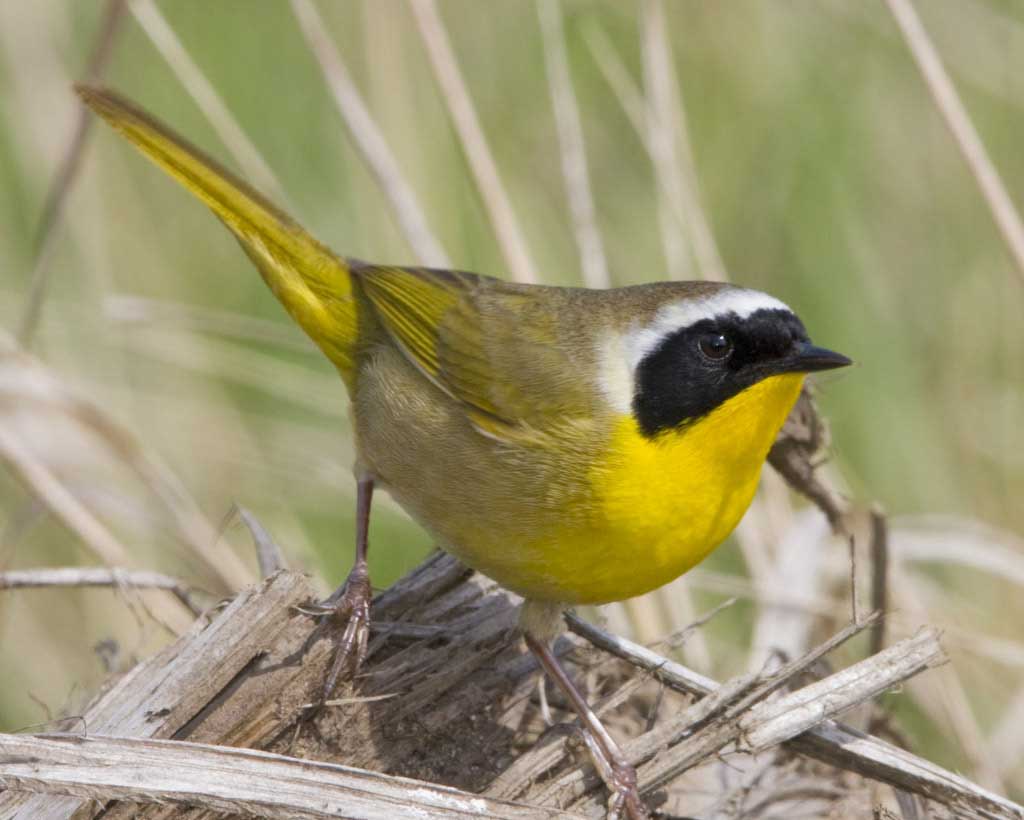
The Common Yellowthroat is frequently observed during the breeding season in Illinois, typically from mid-April to October, appearing in 33% of summer checklists.
These small songbirds exhibit a brownish coloration on their back and vibrant yellow underneath, with long tails. The males possess black masks across their faces, while the intensity of the yellow plumage can vary
geographically, sometimes appearing more olive in certain areas.
Scientific name: Geothlypis trichas
Length: 4.3-5.1 inches (11-13 cm)
Weight: 0.3-0.3 ounces (9-10 g)
Wingspan: 5.9-7.5 inches (15-19 cm)
During the summer, Common Yellowthroats breed across most of North America, excluding Alaska and northern Canada. Some individuals remain year-round along the Gulf Coast and Pacific Southwest. They then migrate south for winter.
Common Yellowthroats are commonly found in marshy or wetland areas, as well as brushy fields with dense, tangled vegetation.
Fun Fact: The black mask of the Common Yellowthroat serves as a visual cue for male birds during courtship. When presented with fake birds lacking a mask, the males respond aggressively, but they do not exhibit the same response to birds without a mask.
3. Yellow-rumped Warbler
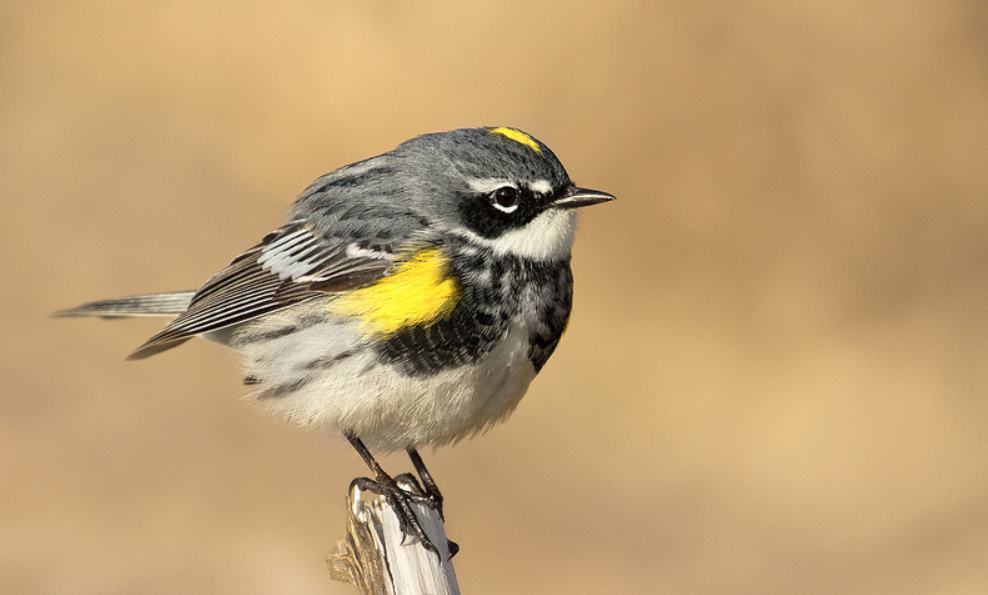
Yellow-rumped Warblers can be seen in Illinois during winter, with their numbers increasing during migration from April to May and September to October. They are recorded in 2% of winter checklists and up to 43% of checklists during migration.
These warblers have a gray coloration with flashes of yellow on their face, sides, and rump, as well as white markings on their wings. Females may exhibit a slightly brownish hue, while winter birds appear paler brown with bright yellow rumps and sides, transitioning back to yellow and gray in spring.
Scientific name: Setophaga coronata
Length: 4.7-5.5 inches (12-14 cm)
Weight: 0.4-0.5 ounces (12-13 g)
Wingspan: 7.5-9.1 inches (19-23 cm)
Yellow-rumped Warblers primarily breed in Canada, parts of the Rockies, and the Appalachian mountains.
During migration, they can be spotted in the Midwest before overwintering in southern and southwestern US states, along the Pacific Coast, and further south into Mexico and Central America.
Yellow-rumped Warblers inhabit coniferous forests, especially during the breeding season. In winter, they can be found in open areas with fruiting shrubs. Their diet primarily consists of insects during the summer and migration, shifting to a fruit-based diet in winter, including bayberry and wax myrtle.
Fun Fact: Yellow-rumped Warblers often form flocks numbering in the thousands during winter and can display aggression towards other species that come too close.
4. Cedar Waxwing

During the summer season in Illinois, Cedar Waxwings are frequently observed from July to September, appearing in 15% of checklists during this period. However, some individuals remain in the state throughout the year.
Cedar Waxwings are elegant and social birds, featuring pale brown plumage on their heads, chests, and crests, which transition to gray on their back, wings, and tail. Their bellies exhibit a pale yellow hue, with bright yellow tips on the tail. They possess a narrow black mask over their eyes and vibrant red wingtips.
Scientific name: Bombycilla cedrorum
Length: 5.5-6.7 inches (14-17 cm)
Weight: 1.1 ounces (32 g)
Wingspan: 8.7-11.8 inches (22-30 cm)
Cedar Waxwings breed in Canada before migrating to the southern US, Mexico, and Central America for winter. They are resident throughout the year in northern US states.
These birds can be found in berry bushes, woodlands, grasslands, towns, and along streams. Their diet primarily consists
of fruit, but they also consume insects during the summer season.
Fun Fact: Cedar Waxwings engage in a unique behavior of exchanging gifts during courtship, passing items between potential mates.
5. Baltimore Oriole Female
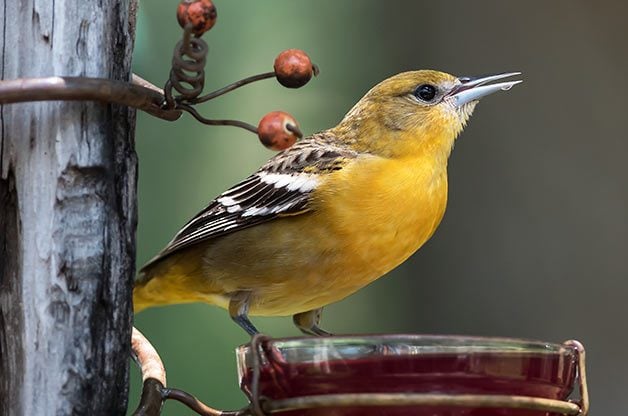
Baltimore Orioles are the third most commonly observed yellow bird during the breeding season in Illinois. They can be spotted from May to September and are present in 26% of summer checklists.
These birds serve as vibrant signs of spring in the eastern part of North America. Adult males exhibit bright orange and black plumage with white wing bars on their black wings.
Females, on the other hand, display yellowish tones on the underside and head, with grayish-brown wings and brownish-yellow backs. Baltimore Orioles are approximately the size of a Robin but possess a more slender build, belonging to the blackbird family.
Scientific name: Icterus galbula
Length: 6.7-7.5 inches (17-19 cm)
Weight: 1.1-1.4 ounces (30-40 g)
Wingspan: 9.1-11.8 inches (23-30 cm)
Baltimore Orioles breed in eastern and central states, including central-southern Canadian provinces and regions along the southern border with the US.
For winter, Baltimore Orioles migrate to Florida, Central America, and the Caribbean, with some departing as early as July.
These birds are commonly found in open woodlands, riverbanks, forest edges, parks, and backyards. They forage for insects and fruit, providing a helpful role in controlling pest populations. Baltimore Orioles consume a variety of fruits, although they can cause damage to crops such as raspberries, mulberries, cherries, bananas, and oranges.
Fun Fact: The flute-like song of Baltimore Orioles is a delightful sound associated with the arrival of spring. Additionally, they produce chattering and sharp alarm calls.
6. Eastern Meadowlark
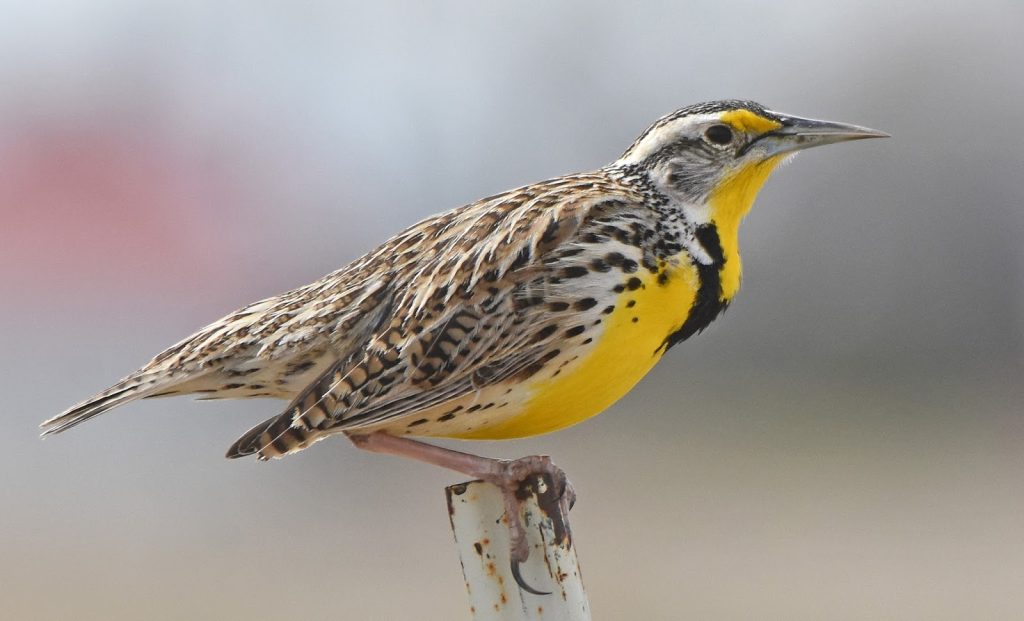
Eastern Meadowlarks, considered a near-threatened species, can be spotted during the breeding season in Illinois, appearing in 13% of summer checklists. Some individuals may also remain in the area throughout the year.
These medium-sized songbirds showcase a bright yellow underside and pale brown plumage with black markings on the back. They possess a distinct black band across their chests.
Scientific name: Sturnella magna
Length: 7.5-10.2 inches (19-26 cm)
Weight: 3.2-5.3 ounces (90-150 g)
Wingspan: 13.8-15.8 inches (35-40 cm)
Eastern Meadowlarks can be found year-round across eastern US states, with breeding populations extending into the Northeast and Canada before embarking on their migration south.
The arrival of spring in the East is often marked by the melodious songs and vibrant displays of Eastern Meadowlarks, although their near-threatened status is a cause for concern.
These birds are typically found on the ground in grasslands and prairies, where they feed on insects. In winter, they gather in large flocks in fields, searching for seeds.
Fun Fact: Eastern Meadowlarks possess an extensive repertoire of songs, with some individuals capable of singing over 100 distinct melodies.
7. Yellow Warbler
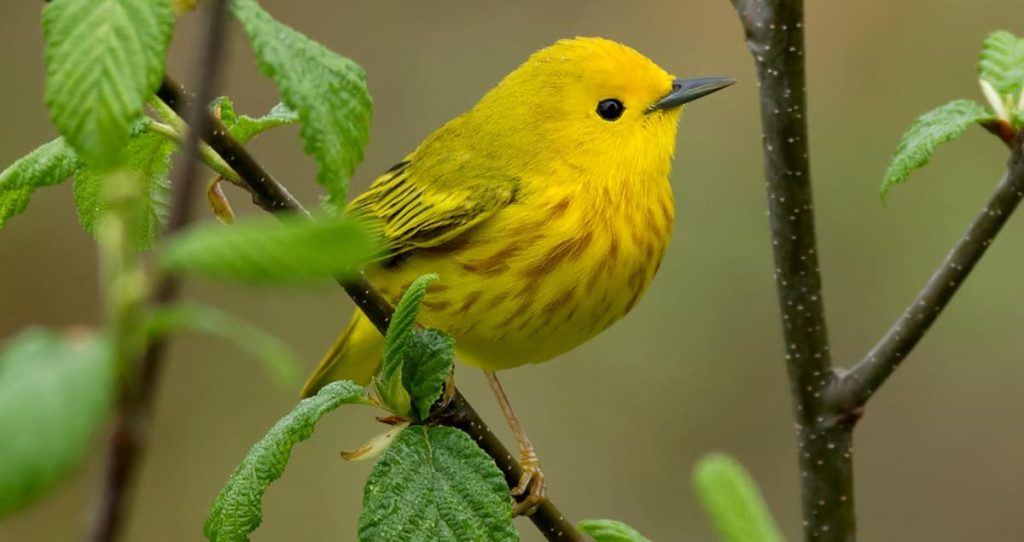
Yellow Warblers can be observed in Illinois from April to October, appearing in 21% of summer checklists.
These small, bright yellow birds have a yellow-green back, with males featuring chestnut streaks on their breast. Females and juveniles exhibit less vibrant coloring compared to the males.
Scientific name: Setophaga petechia
Length: 4.7-5.1 inches (12-13 cm)
Weight: 0.3-0.4 ounces (9-11 g)
Wingspan: 6.3-7.9 inches (16-20 cm)
Yellow Warblers undertake long migrations to breed in Canada and the US, excluding southeastern states, before returning to Central and South America for winter. However, they can also be spotted during migration in southeastern US states.
These birds can be found along streams, wetlands, and the edges of fields, often residing in thickets. Their diet primarily consists of insects, including caterpillars, midges, beetles, bugs, and wasps.
Fun Fact: When cowbirds attempt to lay their eggs in Yellow Warblers’ nests, the Yellow Warblers respond by building new nests on top of the intruded ones, repeating the process multiple times.
8. Palm Warbler
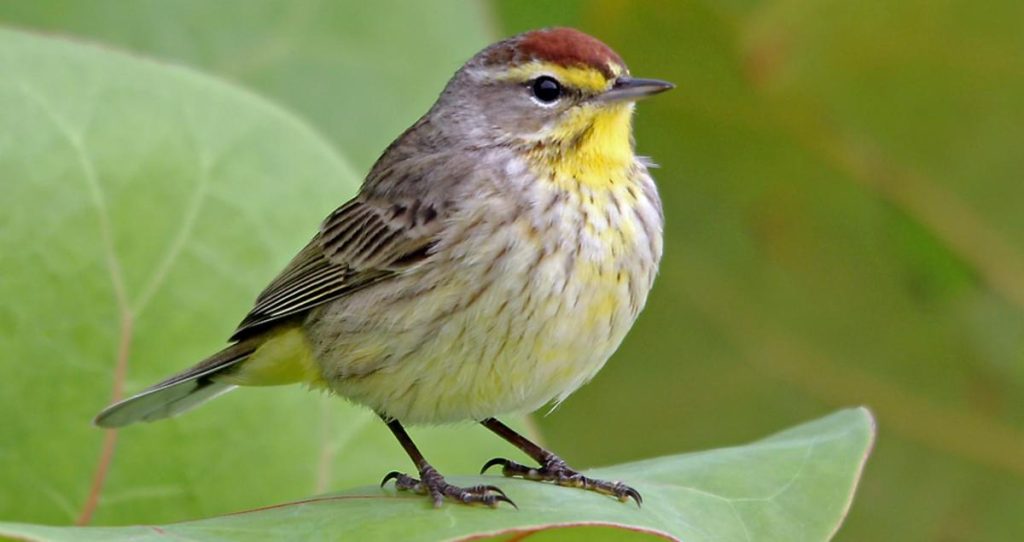
Palm Warblers can be observed in Illinois during migration from April to May and September to October. They are most commonly seen during the spring migration in May, appearing in 36% of checklists during that time.
These warblers feature a rusty red patch on the top of their heads and a brownish-olive color on the rest of their bodies. While they breed in Canada, they can be found in eastern US states during migration and remain along the far south coast and in Florida throughout the year.
Scientific name: Setophaga palmarum
Length: 4.7-5.5 inches (12-14 cm)
Weight: 0.3-0.5 ounces (7-13 g)
Wingspan: 7.9-8.3 inches (20-21 cm)
Palm Warblers breed primarily in Canada and exhibit migratory behavior in eastern US states. Some individuals spend winter in Florida and along the southeastern coast.
These warblers are often spotted in weedy fields, forest edges, and scrubby areas during spring and fall migration. They can be seen foraging along the ground, often mixed with other birds such as Sparrows, Juncos, and Yellow-rumped Warblers.
Fun Fact: Palm Warblers exhibit a unique behavior of walking on the ground while bobbing their tails, which sets them apart from most other warbler species.
9. American Redstart Female
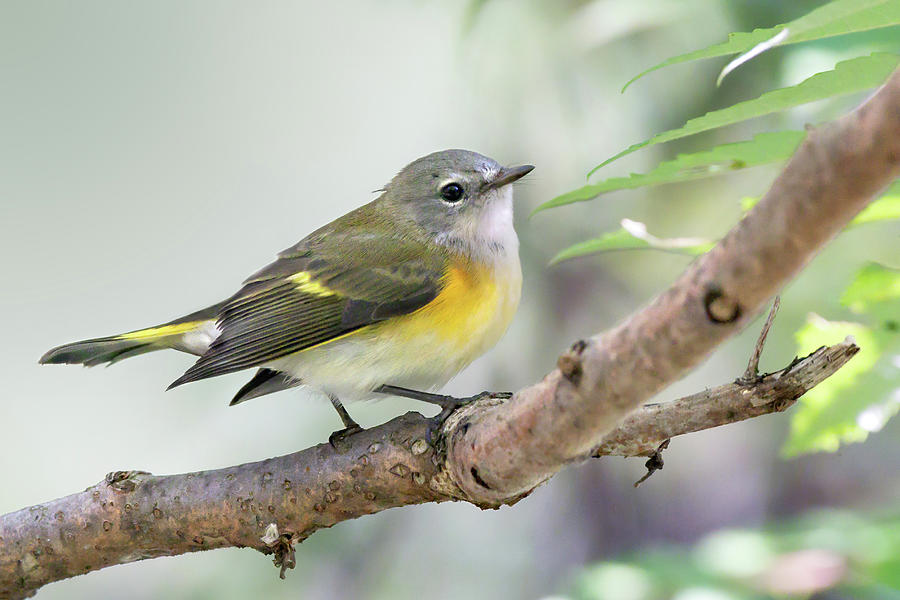
American Redstarts are present during the breeding season in Illinois, although they are more commonly observed during migration in May and September.
Male American Redstarts display a predominantly black plumage with bright orange patches and a white belly. Females possess olive-gray feathers instead of black and feature numerous yellow patches.
Scientific name: Setophaga ruticilla
Length: 4.3-5.1 inches (11-13 cm)
Weight: 0.2-0.3 ounces (6-9 g)
Wingspan: 6.3-7.5 inches (16-19 cm)
American Redstarts breed in eastern US states, Canada, and northwestern US states. They can also be seen during migration in central and western US states.
These birds can be found in deciduous woodlands, parks, and thickets, where they forage for insects and consume berries such as serviceberry and magnolia.
Fun Fact: Male American Redstarts only feed specific chicks, rather than providing food to all offspring.
10. Magnolia Warbler
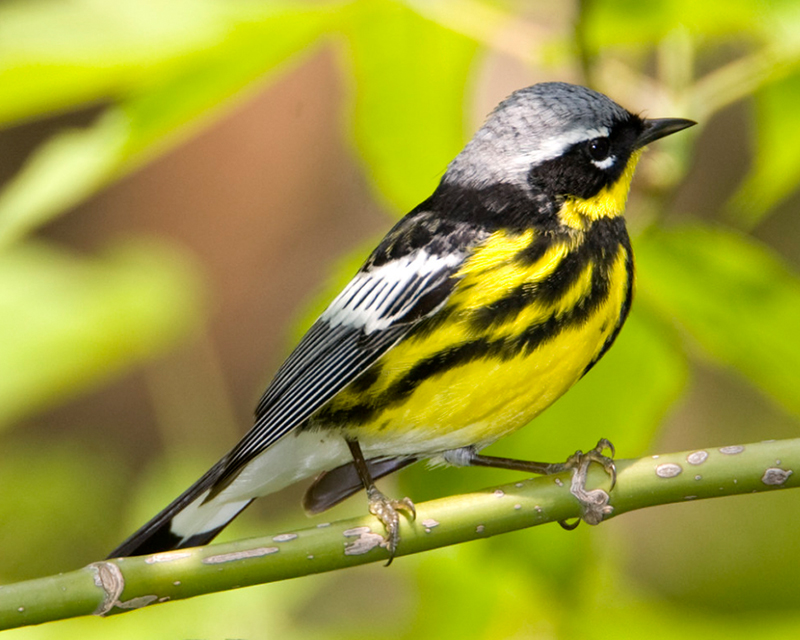
Magnolia Warblers are primarily observed in Illinois during spring and fall migration, particularly in May and from mid-August to October.
Male Magnolia Warblers exhibit a black back and yellow underside. They possess black streaking that forms a distinctive “necklace” across their necks and down their bellies. Females have a grayer back and lack the pronounced streaking on the belly.
Scientific name: Setophaga magnolia
Length: 4.3-5.1 inches (11-13 cm)
Weight: 0.2-0.5 ounces (6-15 g)
Wingspan: 6.3-7.9 inches (16-20 cm)
Magnolia Warblers breed across Canada and northeastern US states. During migration, they can be observed in eastern US states. These birds spend their winters in Central America and the Caribbean.
Magnolia Warblers are often found on low branches in forests, parks, and during migration. Their diet consists of insects and spiders.
Fun Fact: To attract females and ward off rivals, Magnolia Warblers showcase the white spots on their tails as part of their courtship displays.
11. Nashville Warbler
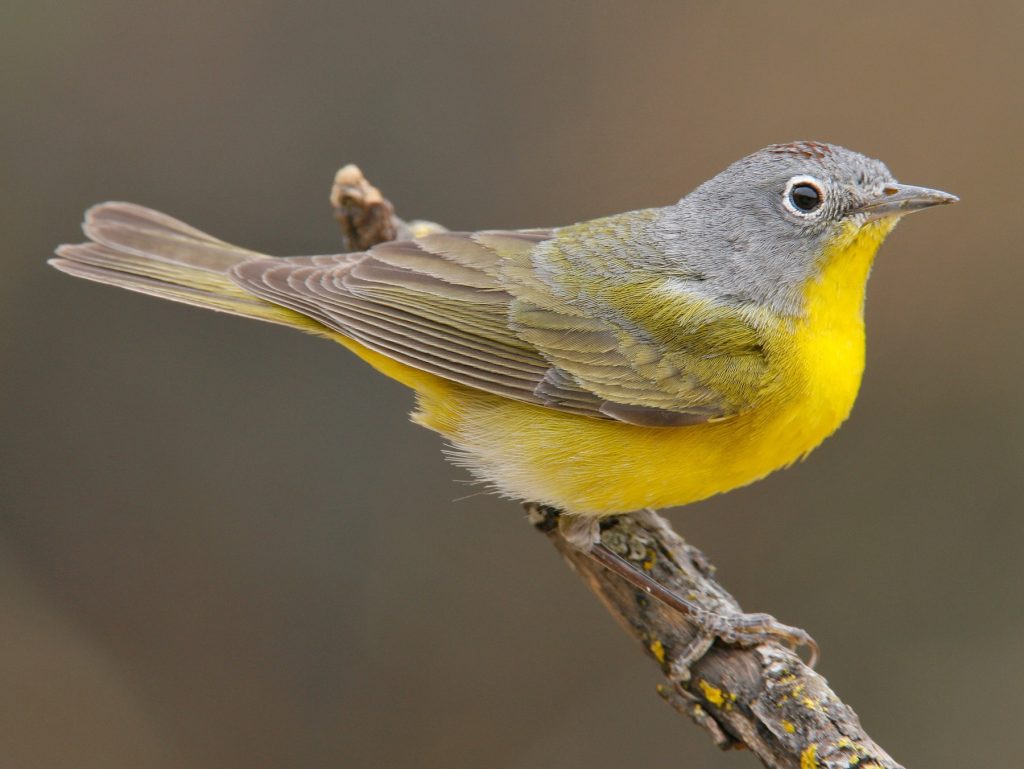
During the migration periods in April to May and September to October, Nashville Warblers are commonly seen in Illinois.
Nashville Warblers have a greenish-yellow back, gray head with a white eyering, and mostly yellow undersides with white lower bellies. The males have brighter colors compared to females and juveniles.
Scientific name: Leiothlypis ruficapilla
Length: 4.3-5.1 inches (11-13 cm)
Weight: 0.2-0.5 ounces (6.7-13.9 g)
Wingspan: 6.7-7.9 inches (17-20 cm)
Nashville Warblers breed in northeastern US states and Canada, with a smaller population in northwestern US states and British Columbia. They can be observed during migration throughout the US and spend winters mainly in Mexico.
These warblers can be found in scrubby habitats and low deciduous forests, where they actively hunt for insects.
Fun Fact: Nashville Warblers are known for their unique migration behavior, where they primarily migrate along the Atlantic Coast during their first year but switch to an inland migration route in subsequent years.
12. Dickcissel
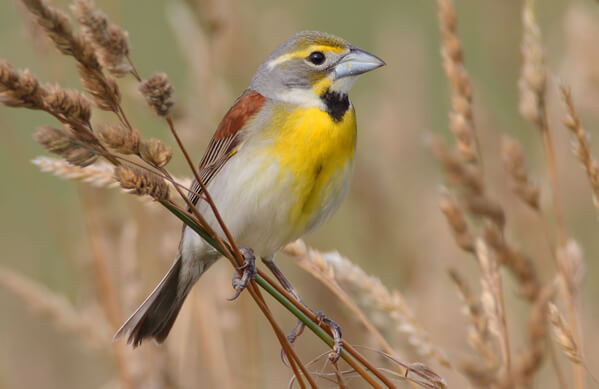
Illinois is a breeding ground for the Dickcissel, and it can be commonly observed from May to September, appearing in 9% of checklists.
Male Dickcissels have a striking appearance with a black throat patch and yellow chest. They also feature a yellow eyebrow line against a grayish head. Females possess similar markings but with a paler or duller tone, lacking the black throat patch.
Scientific name: Spiza americana
Length: 5.5-6.3 inches (14-16 cm)
Weight: 0.9-1.4 ounces (25.6-38.4 g)
Wingspan: 9.8-10.2 inches (24.8-26 cm)
Dickcissels breed in the Central and Great Plains of the US and migrate to Mexico, Central America, and northern South America.
These birds can be found in meadows, prairies, tall grasslands, light-grazed pastures, and roadsides. They feed on insects such as grasshoppers, caterpillars, beetles, and crickets during the summer and consume seeds, weeds, grasses, and cultivated grain at other times.
Fun Fact: During the fall migration, Dickcissel populations can gather in large numbers, ranging from thousands to millions when they reach their winter grounds.
13. Black-throated Green Warblers
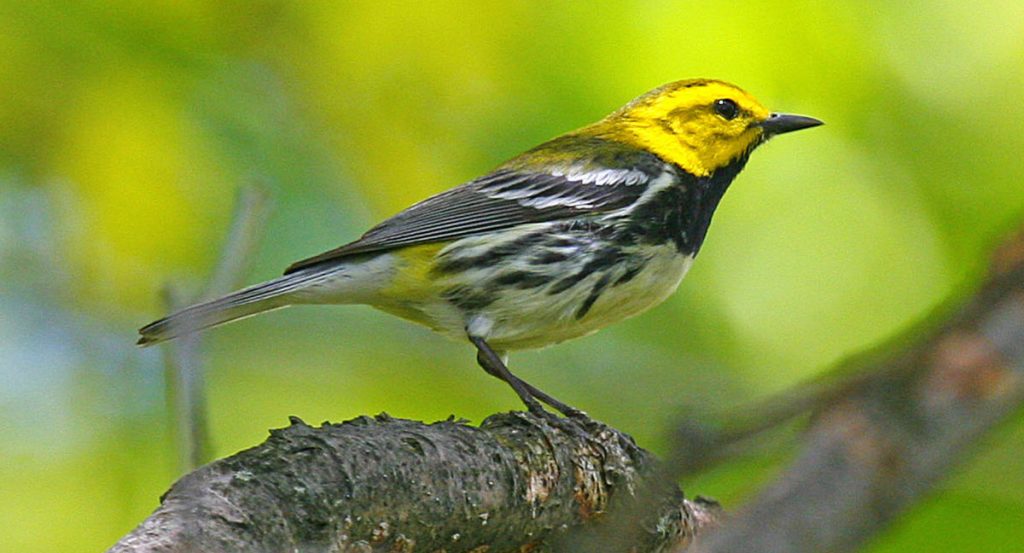
Black-throated Green Warblers can be observed during migration in Illinois, particularly in May and September.
Black-throated Green Warblers are small yellow songbirds with yellow faces and heads, olive-yellow backs, and black streaking on the sides and wings. Their bellies are whitish in color.
Scientific name: Setophaga virens
Length: 4.3-4.7 inches (11-12 cm)
Weight: 0.3-0.4 ounces (7-11 g)
Wingspan: 6.7-7.9 inches (17-20 cm)
These warblers migrate over the eastern US during their long journey to breeding grounds in northeastern US states and Canada. They spend winters in Mexico, northern South America, and the Caribbean.
Black-throated Green Warblers can be found high up in forests, where they actively search for insects. The black throat distinguishes them from other small yellow birds.
Fun Fact: Male Black-throated Green Warblers are known for their impressive singing abilities, producing over 400 songs per hour during peak singing times.
14. Scarlet Tanagers
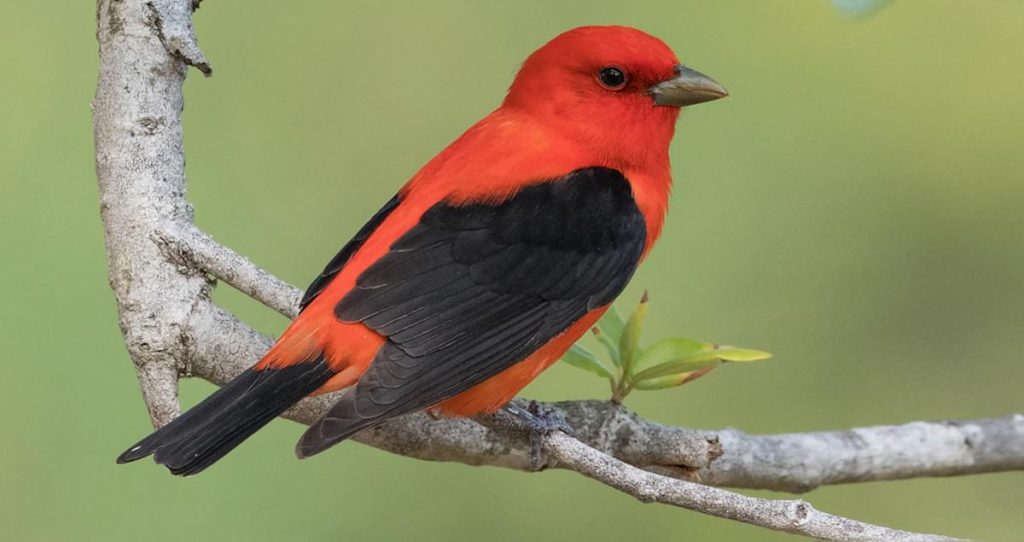
Scarlet Tanagers spend their summers in Illinois and are commonly observed during the spring migration in May, appearing in 17% of checklists.
Female Scarlet Tanagers have yellowish-green bodies with darker wings and tails. Males exhibit vibrant colors with bright red plumage, black wings and tails, thick bills, and short tails.
Scientific name: Piranga olivacea
Length: 6.3-6.7 inches (16-17 cm)
Weight: 0.8-1.3 ounces (23-38 g)
Wingspan: 9.8-11.4 inches (25-29 cm)
During the summer, Scarlet Tanagers breed in eastern forests and migrate to western South America. They can be spotted in southeastern states during migration.
Scarlet Tanagers prefer to stay high in the forest canopy, making them challenging to spot. They primarily feed on insects and occasionally consume berries.
Fun Fact: Scarlet Tanagers engage in singing battles with rivals, and these competitions can sometimes escalate into physical fights.
15. Orchard Orioles
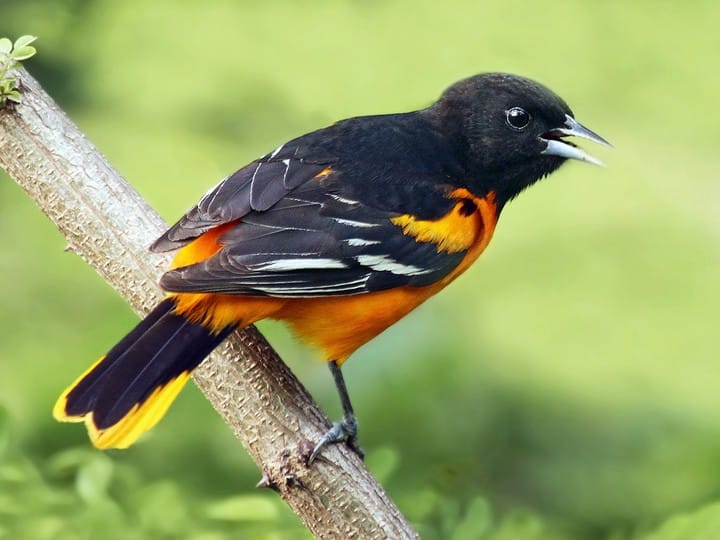
Orchard Orioles can be seen in Illinois during the breeding season from April to September, accounting for 6% of summer checklists.
Female Orchard Orioles display a greenish-yellow overall coloration with a paler underside and darker back, wings, and white wingbars.
Males, on the other hand, have bold coloring with black heads and backs, along with reddish undersides.
Scientific name: Icterus spurius
Length: 5.9-7.1 inches (15-18 cm)
Weight: 0.6-1.0 ounces (16-28 g)
Wingspan: 9.8 inches (25 cm)
Orchard Orioles breed in the eastern half of the United States before migrating to Mexico and Central America for the winter.
These orioles can be found in open woodlands, riverbanks, open shrublands, farms, and even backyards. They construct hanging pouch-like nests.
Orchard Orioles primarily feed on insects such as ants, caterpillars, beetles, and grasshoppers, but they also consume nectar from flowers and various fruits.
Fun Fact: Orchard Orioles hold the distinction of being the smallest species of blackbird in North America.
16. Yellow-throated Vireos
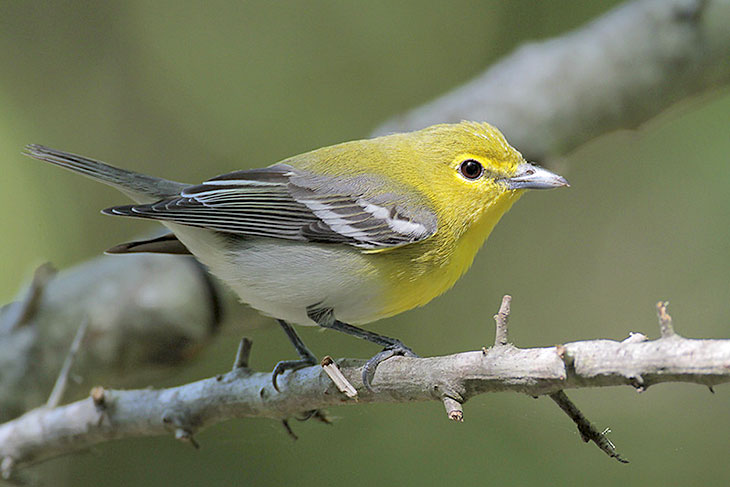
Yellow-throated Vireos spend the breeding season in Illinois and are commonly observed from April to October, accounting for 4% of summer checklists.
Yellow-throated Vireos are bright yellow and gray birds with olive-colored heads. They feature vibrant yellow throats and chests, white bellies, and grayish-brown backs with white streaks.
Scientific name: Vireo flavifrons
Length: 5.1-5.9 inches (13-15 cm)
Weight: 0.5-0.7 ounces (15-21 g)
Wingspan: 9.1 inches (23 cm)
Yellow-throated Vireos breed in eastern US states and spend their winters in Central and South America, as well as the Caribbean.
These vireos can be spotted in mixed woodlands, where they actively hunt for insects and occasionally consume berries.
Fun Fact: Male Yellow-throated Vireos attract females by pretending to build nests, creating several piles of twigs in different locations to entice potential mates.
17. Wilson’s Warblers

Wilson’s Warblers can be seen migrating across Illinois during May and September.
Wilson’s Warblers are small, round, and yellow warblers with males having a large black cap and females sporting a smaller black cap.
Scientific name: Cardellina pusilla
Length: 3.9-4.7 inches (10-12 cm)
Weight: 0.2-0.3 ounces (5-10 g)
Wingspan: 5.5-6.7 inches (14-17 cm)
These warblers breed in Canada, Alaska, and northwestern US states, migrating across the entire US except for the northeastern region. They spend winters in Mexico, Central America, and the Caribbean.
Wilson’s Warblers can be found along streams in thickets and near forest edges, where they actively forage for insects, larvae, and spiders.
Fun Fact: To distract potential nest predators, Wilson’s Warblers perform a display of a broken wing, luring the predator away before flying off.
18. White-eyed Vireos

White-eyed Vireos spend the breeding season in Illinois and are mainly observed from April to September, accounting for 2% of summer checklists.
White-eyed Vireos have gray heads with yellow coloring around their foreheads and distinct white eyes. Their chests and throats are white, while their sides are yellow. They possess greenish backs with darker wings and two white wingbars.
Scientific name: Vireo griseus
Length: 4.3-5.1 inches (11-13 cm)
Weight: 0.3-0.5 ounces (10-14 g)
Wingspan: 6.7 inches (17 cm)
White-eyed Vireos spend summers across the southeastern United States, often concealed within thickets. Some populations near the coast remain year-round. They migrate to the southeast coast of Mexico and the Caribbean for winter.
These vireos can be found in overgrown pastures, brambles, and shrublands, where they feed on insects, flies, spiders, and occasionally consume berries.
Fun Fact: During winter, both male and female White-eyed Vireos sing, but during spring and summer, only the males showcase their vocal abilities, singing extensively from dawn until midday.
19. Orange-crowned Warblers
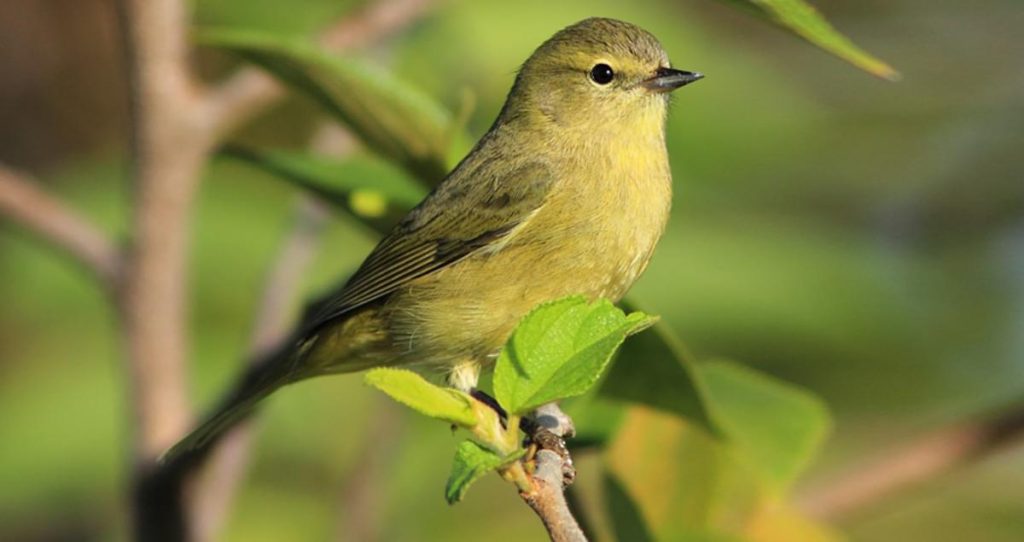
Orange-crowned Warblers are spotted migrating across Illinois, with the majority observed from mid-April to May and September to November.
Orange-crowned Warblers are not as vibrant as other warblers, displaying yellow-olive coloring, which appears more yellow along the Pacific Coast. Their orange crown is rarely visible.
Scientific name: Leiothlypis celata
Length: 4.3-5.5 inches (11-14 cm)
Weight: 0.3-0.4 ounces (7-11 g)
Wingspan: 7.5 inches (19 cm)
These warblers breed in Canada and western US states, migrating across the entire US except for the northeastern region. They winter in Mexico, Central America, and parts of the Caribbean.
Orange-crowned Warblers can be found in shrubs, low vegetation, and open woodlands, actively foraging for insects, larvae, spiders, and occasionally feeding on fruits and berries.
Fun Fact: Orange-crowned Warblers are known to drink sap from the wells created by sapsuckers and woodpeckers.
20. Cape May Warblers
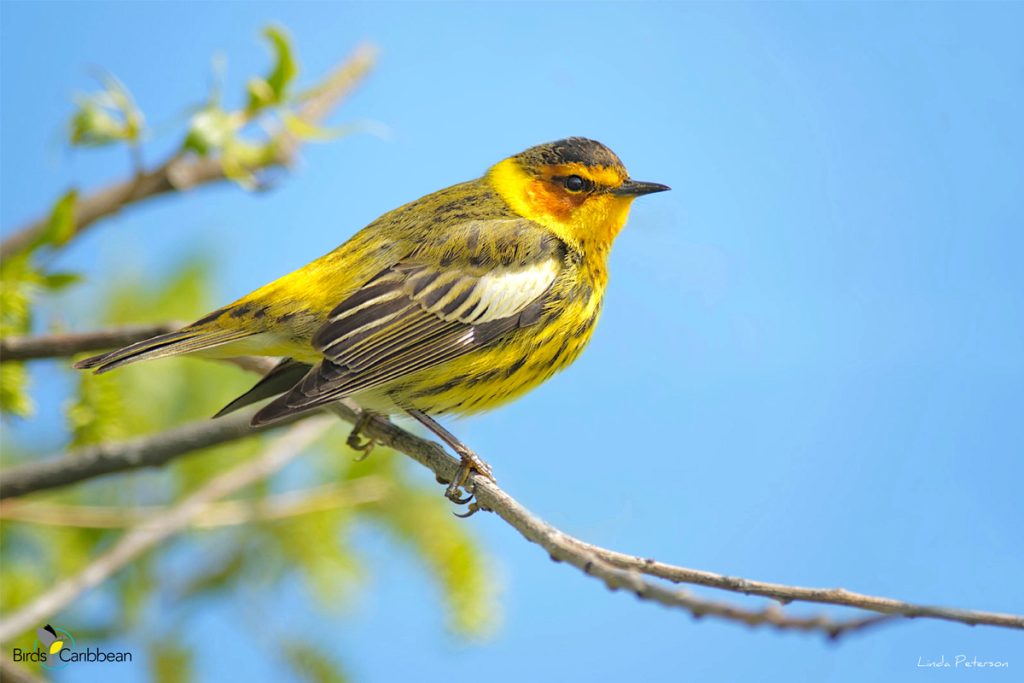
Cape May Warblers are commonly observed during their migration through Illinois in May and September.
Male Cape May Warblers feature distinct chestnut cheeks, dark caps, and a ring of yellow around their necks. They have mottled yellow-olive upperparts and yellow undersides with dark streaks.
Scientific name: Setophaga tigrina
Length: 4.7-5.1 inches (12-13 cm)
Weight: 0.4-0.5 ounces (10.2-15.2 g)
Wingspan: 7.9-8.7 inches (20-22 cm)
Cape May Warblers migrate over eastern US states to their breeding grounds in Canada. They spend winters in the Caribbean and a narrow coastal region of the Yucatan Peninsula and Central America.
These warblers can be found in spruce forests during the breeding season and various
habitats, especially near wood edges and scrub, where they search for insects during migration.
Fun Fact: Cape May Warblers possess unique tongues shaped like tubes, allowing them to lap up nectar from flowers.
21. Summer Tanagers
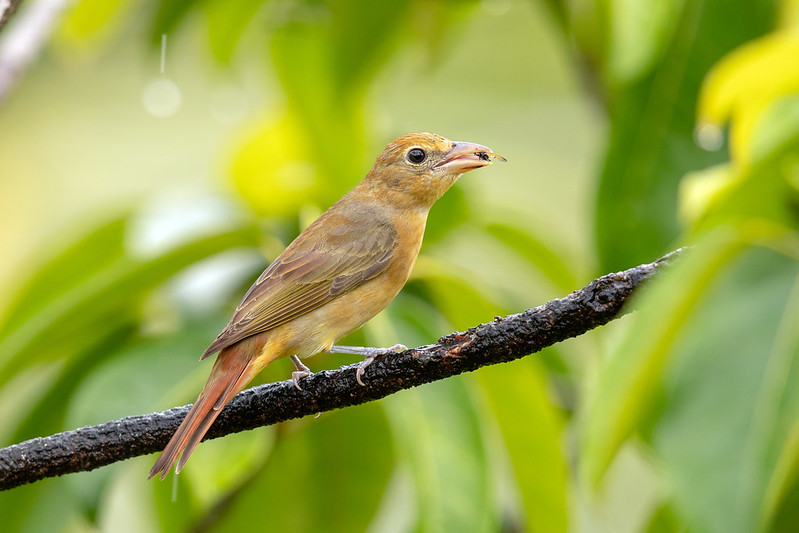
During the breeding season in Illinois from April to October, Summer Tanagers are frequently observed and appear on 2% of checklists.
With their large, chunky beaks, male Summer Tanagers are vibrant red birds. Females and juveniles, on the other hand, display yellow coloration with hints of green on their backs.
Scientific name: Piranga rubra
Length: 6.7 inches (17 cm)
Weight: 1.1 ounces (30 g)
Summer Tanagers breed in southern and eastern US states before migrating to Central and South America for the winter.
These birds can be found in open woodlands, where they actively hunt bees and wasps in mid-flight. They catch their prey and eliminate the stinger by beating it against a branch before consuming it.
Fun Fact: The nests of Summer Tanagers are constructed by the females using grass and other plant materials at the end of overhanging branches. Although their nests are not particularly well-built, they typically hold around four eggs. The eggs hatch in approximately ten days, and the young birds leave the nest about ten days after that.
22. Canada Warblers
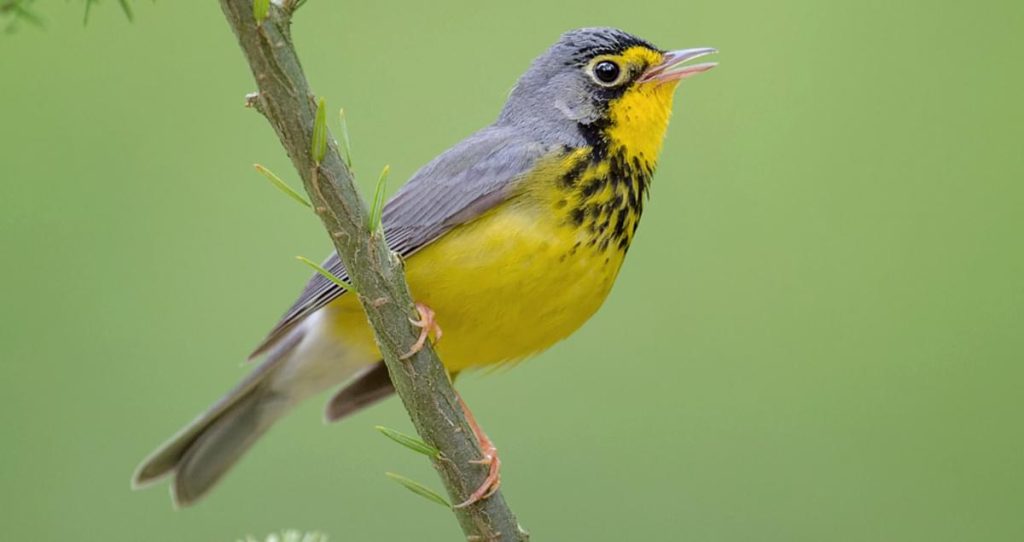
Illinois occasionally witnesses the presence of Canada Warblers during spring and fall migration, with a higher occurrence in May, accounting for 12% of checklists.
Canada Warblers bear resemblance to Magnolia Warblers and share a similar range. However, they have grayish-black backs, and the males’ black “necklace” does not extend over the belly, only covering the chest. Their chests, bellies, and throats are yellow.
Females and immature birds have a paler appearance with a less prominent “necklace.”
Scientific name: Cardellina canadensis
Length: 4.7-5.9 inches (12-15 cm)
Weight: 0.3-0.5 ounces (9-13 g)
Wingspan: 6.7-8.7 inches (17-22 cm)
Canada Warblers breed in Canada and northeastern US states, and during migration, they can be observed across the eastern half of the US. They winter in western South America.
These warblers are typically found in rhododendron-filled conifer forests or aspen and poplar forests, where they forage for insects and spiders. However, locating them can be challenging as their population numbers have been declining.
Fun Fact: Canada Warblers embark on impressive migrations, covering over 3000 miles each way between their winter and summer grounds.
23. Prothonotary Warblers
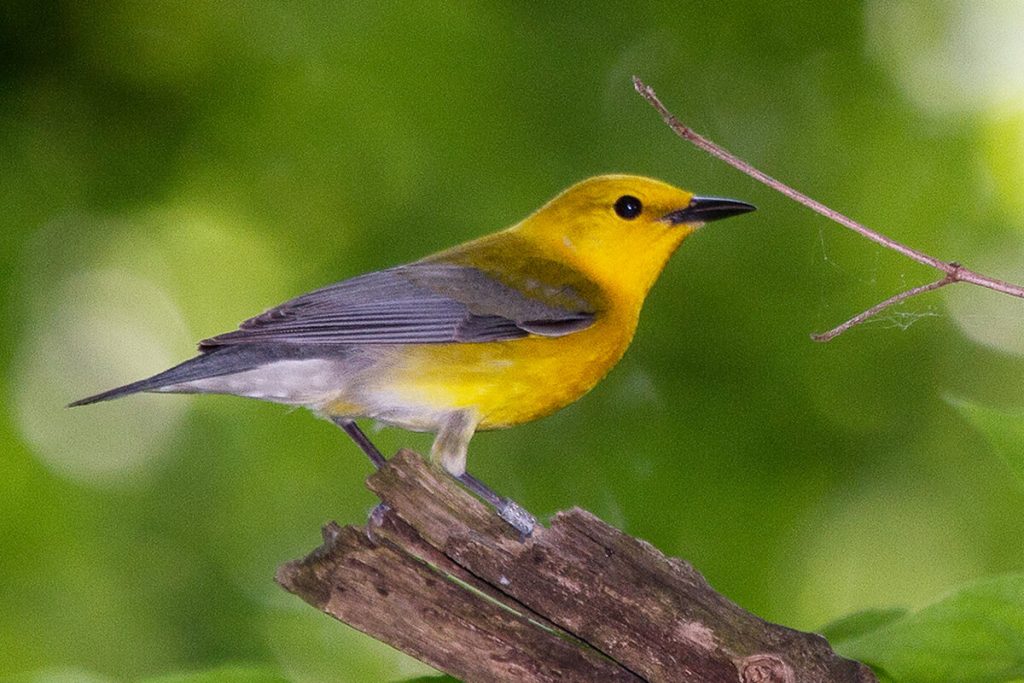
Prothonotary Warblers spend the breeding season in Illinois from April to September, and they are recorded in 2% of summer checklists.
Prothonotary Warblers showcase bright yellow bodies with blue-gray wings and tails. They are larger than typical warblers, possess thick black beaks, and have white undersides of their tails. Females exhibit a less vibrant coloration than males.
Scientific name: Protonotaria citrea
Length: 5.1 inches (13 cm)
Weight: 0.44 ounces (12.5 g)
Wingspan: 8.75 inches (22 cm)
Prothonotary Warblers breed in eastern US states and migrate to Mexico, Central America, and the Caribbean for winter.
These warblers can be found near streams and wet woodlands, where they actively forage for spiders, insects, and snails. They may also consume fruit and seeds during the winter months.
Fun Fact: The nests of Prothonotary Warblers are constructed in Spanish moss hanging from tree branches. The female builds the nest using grass, leaves, and other plant materials.
24. Pine Warblers

Pine Warblers make appearances in Illinois during spring and fall migration, with the highest occurrence in April, accounting for 5% of checklists.
Pine Warblers are small, plump birds with yellow plumage, olive backs, white lower bellies, and gray wingbars. Females may exhibit a browner appearance with increased white on the belly.
Scientific name: Setophaga pinus
Length: 5.1-5.5 inches (13-14 cm)
Weight: 0.3-0.5 ounces (9-15 g)
Wingspan: 7.5-9.1 inches (19-23 cm)
Pine Warblers breed in northeastern US states and then migrate to southeastern US states. However, some individuals remain in the southeastern states throughout the year.
These warblers primarily inhabit pine forests, where they feed on caterpillars, beetles, spiders, and other insects and larvae. During colder weather, they may supplement their diet with fruit and seeds.
Fun Fact: Pine Warblers are known for their unique adaptation of mainly consuming seeds among warblers, making them more likely to visit backyard feeders.
25. Blue-winged Warblers
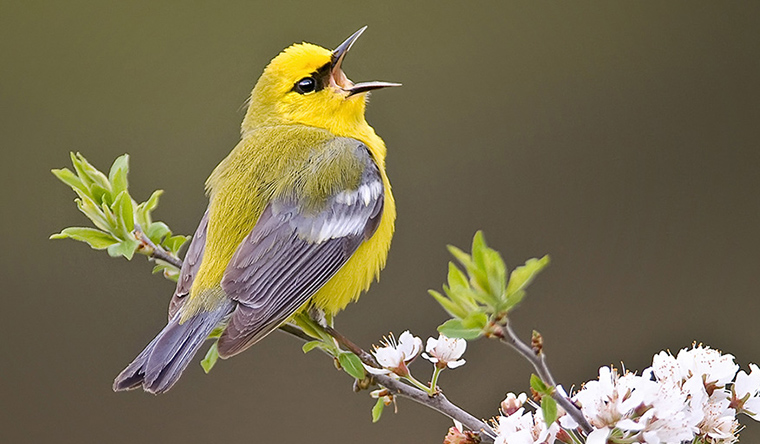
Blue-winged Warblers are commonly observed during the spring and fall migration in Illinois.
These warblers derive their name from the bluish-gray hue of their wings. Adult birds display yellow-green coloration on their upper parts, with a black eye line extending from their long bill across the eye, giving them an intense expression.
The breast and belly of Blue-winged Warblers are predominantly bright yellow, with females exhibiting a slightly paler shade that is often indistinguishable from males. Adults possess two white wing bars, while juvenile birds also have wing bars, albeit faint and nearly imperceptible.
Scientific name: Vermivora cyanoptera
Length: 4.75 inches (12 cm)
Weight: 0.3 ounces (9 g)
Wingspan: 6.75 – 7.5 inches (17 – 19 cm)
Blue-winged Warblers breed in eastern US states, excluding southern states, and migrate to Mexico, Central America, and the Caribbean for winter.
These warblers primarily inhabit abandoned brushy fields and pastures, forest edges, and thickets. They often prefer higher elevation areas with ample grass and canopy cover.
Blue-winged Warblers feed on insects and spiders found in various plants and trees. They have been observed hanging upside down from branches to inspect the undersides of leaves for insect larvae, which they use to feed their young.
Fun Fact: Blue-winged Warblers frequently hybridize with Golden-winged Warblers, resulting in the production of Brewster’s and Lawrence’s Warblers.
26. Yellow-throated Warblers
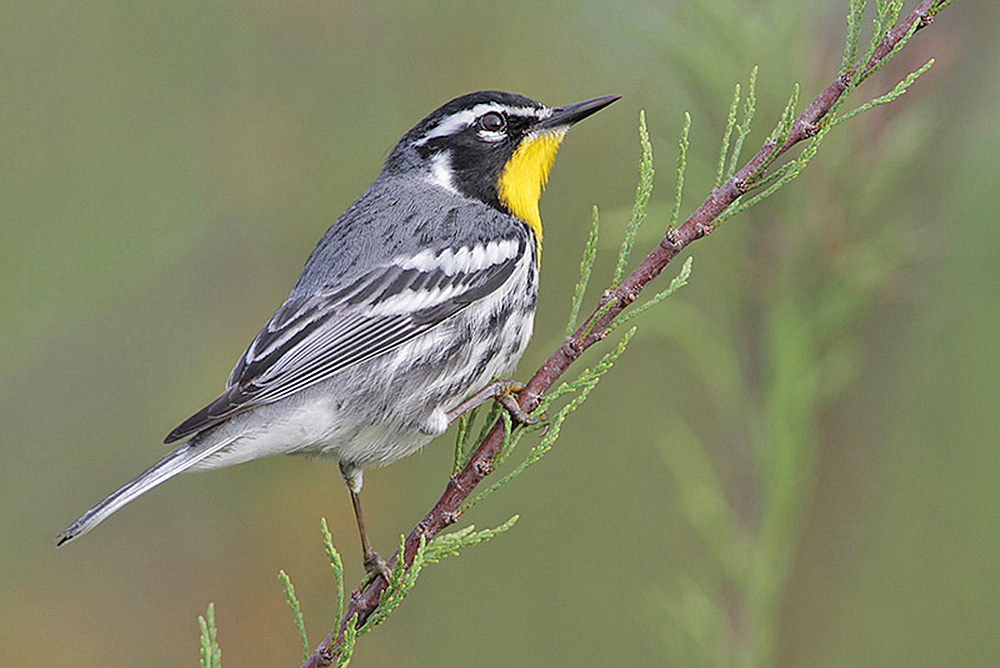
Yellow-throated Warblers spend the breeding season in Illinois and appear on 1% of summer checklists.
Yellow-throated Warblers feature gray and white bodies adorned with black stripes and bright yellow throats. When viewed from below, their bellies and tails appear white. Females and juveniles exhibit paler coloration.
Scientific name: Setophaga dominica
Length: 5.1-5.5 inches (13-14 cm)
Weight: 0.3-0.4 ounces (9-11 g)
Wingspan: 8.3 inches (21 cm)
Yellow-throated Warblers breed across southeastern US states and spend their winters in Florida, the Caribbean, and along the Gulf Coast into Central America. Some individuals may remain in Florida year-round.
These warblers can typically be found at the top of pine trees while foraging for insects. However, during migration, they may forage at lower heights.
Fun Fact: Yellow-throated Warblers are among the few bird species that have experienced an increase in population numbers in recent years. Initially, their numbers declined, and their range shrank, but since 1966, they have shown a 50% increase.
27. Hooded Warblers
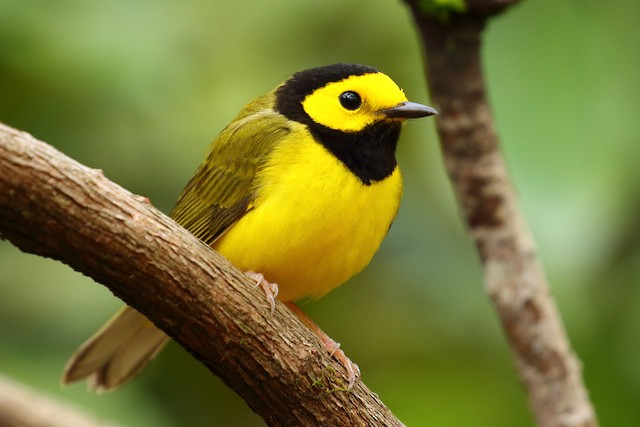
Hooded Warblers breed in Illinois and are present from April until mid-October, accounting for 1% of summer checklists.
Male Hooded Warblers exhibit bright yellow faces with distinct black hoods and throats. They showcase yellow undersides and olive-green upperparts. When flicking their tails up, the white undersides become visible.
Females and immature Hooded Warblers possess a more yellowish coloration without the black facial markings.
Scientific name: Setophaga citrina
Length: 5.1 inches (13 cm)
Weight: 0.3-0.4 ounces (9-12 g)
Wingspan: 6.9 inches (17.5 cm)
Hooded Warblers breed in eastern US states before migrating to Central America and the Caribbean for winter.
These warblers prefer forests with dense understories, where they actively hunt for insects and spiders.
Fun Fact: Hooded Warblers have white spots on their tails, which are believed to startle insects, aiding in their capture.
28. Yellow-headed Blackbirds
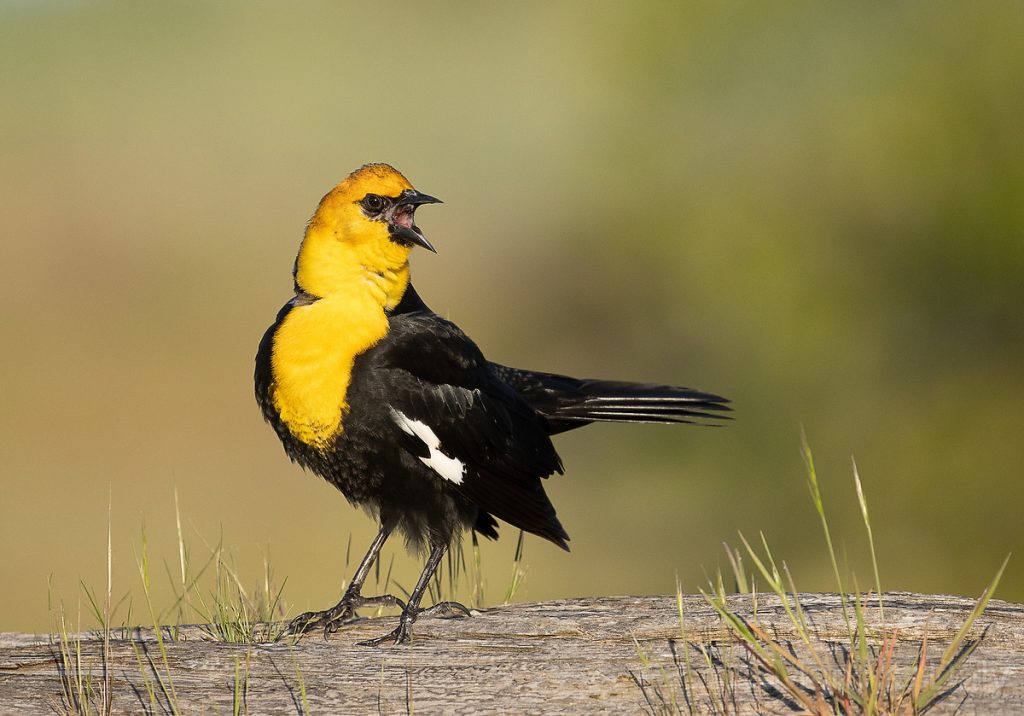
Yellow-headed Blackbirds are not frequently found in Illinois, but they can be observed during the breeding season from mid-April to July.
Yellow-headed Blackbirds are striking birds with glossy black bodies and vibrant yellow heads and chests. They also feature white patches on their wings in males. Females display a brown coloration instead of black, and their yellow head is less intense. They are larger than Red-winged Blackbirds.
Scientific name: Xanthocephalus xanthocephalus
Length: 8.3-10.2 inches (21-26 cm)
Weight: 1.6-3.5 ounces (44-100 g)
Wingspan: 16.5-17.3 inches (42-44 cm)
Yellow-headed Blackbirds breed in western and prairie wetlands, constructing their nests in the reeds. They forage across surrounding wetlands, grasslands, and fields, primarily feeding on insects during the summer.
Following breeding, Yellow-headed Blackbirds migrate to fields and farmland in Southwest states and Mexico for winter, forming large flocks.
Yellow-headed Blackbirds have a varied diet, consuming insects during summer and switching to seeds and grains during winter.
Fun Fact: Yellow-headed Blackbirds possess powerful bills that allow them to crush seeds that are too tough for other smaller birds to open, often benefiting from the leftovers at feeding locations.
29. Prairie Warblers
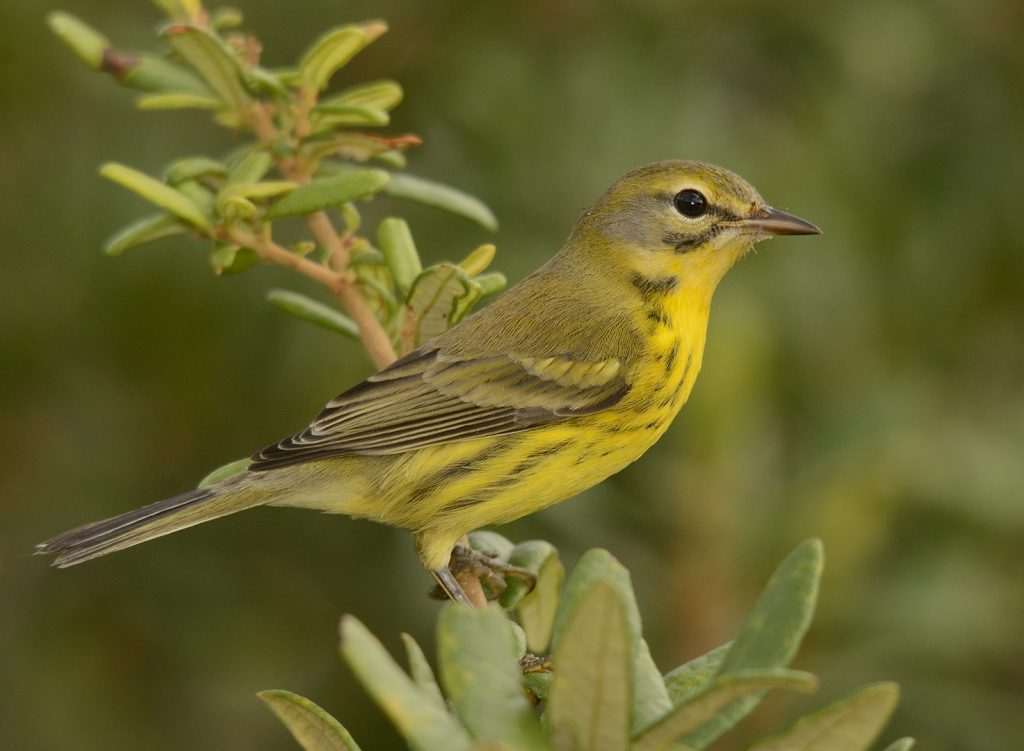
Prairie Warblers spend the breeding season in Illinois and are typically observed from mid-April to June.
Prairie Warblers are small songbirds, featuring olive-green backs and yellow throats and bellies. They exhibit black streaks on the sides and a dark semicircle under the eye. Female Prairie Warblers display duller colors compared to males.
Scientific name: Setophaga discolor
Length: 4.3 inches (11 cm)
Weight: 0.2-0.3 ounces (6.4-8.8 g)
Prairie Warblers breed in eastern and southeastern US states and migrate to Florida, the Caribbean, and some coastal areas of Central America for winter.
While their name implies a prairie habitat, these warblers predominantly inhabit fields and forests, where they feed on insects, spiders, and snails. They are known for their distinctive tail-bobbing behavior while foraging.
Fun Fact: Male Prairie Warblers sing two distinct songs, one used to attract females and another to deter other competing males.
30. Western Meadowlarks
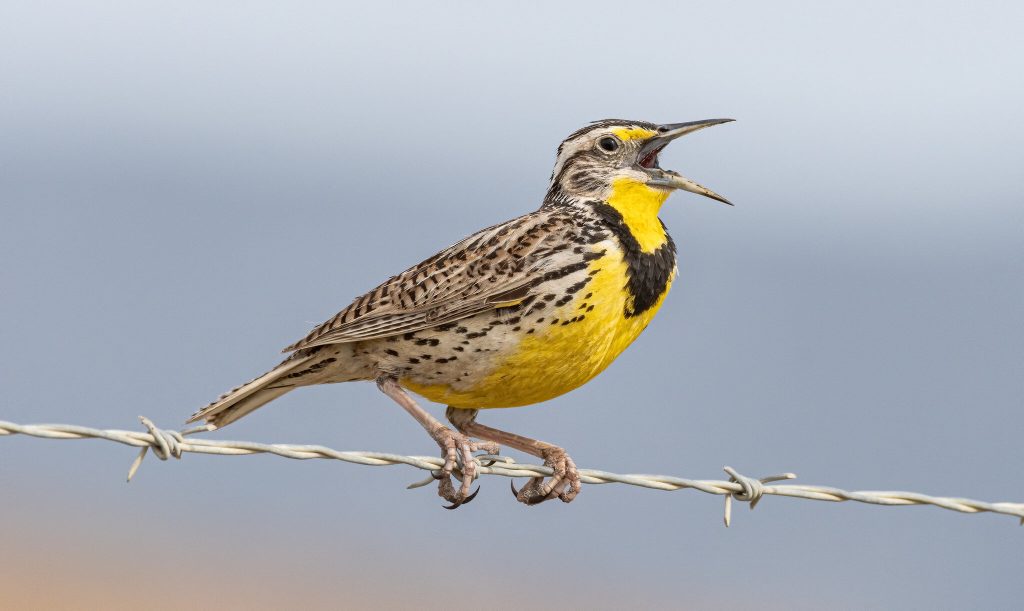
Western Meadowlarks are not commonly found in Illinois, but they can be seen during the summer.
With their bright yellow bellies and melodious songs, Western Meadowlarks bring joy to any observer.
These birds, belonging to the blackbird family, are approximately the size of a Robin. They possess shades of brown and white on their upperparts, with a distinctive black V-shaped band across their vibrant yellow chests, which turns gray in winter.
Scientific name: Sturnella neglecta
Length: 6.3-10.2 inches (16-26 cm)
Weight: 3.1-4.1 ounces (89-115 g)
Wingspan: 16.1 inches (41 cm)
Western Meadowlarks breed in northern US states and Canada, migrating to more southern states during winter. However, some individuals in the western and midwestern regions remain year-round.
These birds are typically found in grasslands, meadows, and fields, foraging on the ground. While primarily insectivorous during the summer, they consume seeds, berries, and small fruits during the winter.
Fun Fact: Western Meadowlarks have been designated as the state bird for six US states.
31. Western Kingbirds

Western Kingbirds can be observed in Illinois during the breeding season from May to October, although they are not commonly found here.
Western Kingbirds are large flycatchers, characterized by yellow bellies, whitish chests, gray heads, grayish-brown wings, and black tails with white edges.
Scientific name: Tyrannus verticalis
Length: 7.9-9.4 inches (20-24 cm)
Weight: 1.3-1.6 ounces (37-46 g)
Wingspan: 15.0-16.1 inches (38-41 cm)
Western Kingbirds breed during summer in western US states, the plains area, and into Canada. They migrate to Mexico, Central America, and the Caribbean, although some individuals may overwinter in southern Florida.
These kingbirds are often found in open habitats and can frequently be seen perched on fences and utility lines, patiently waiting for insects to fly by before catching them in mid-flight.
Fun Fact: Western Kingbird parents continue to provide food to their young for approximately three weeks after they leave the nest.
32. Evening Grosbeaks
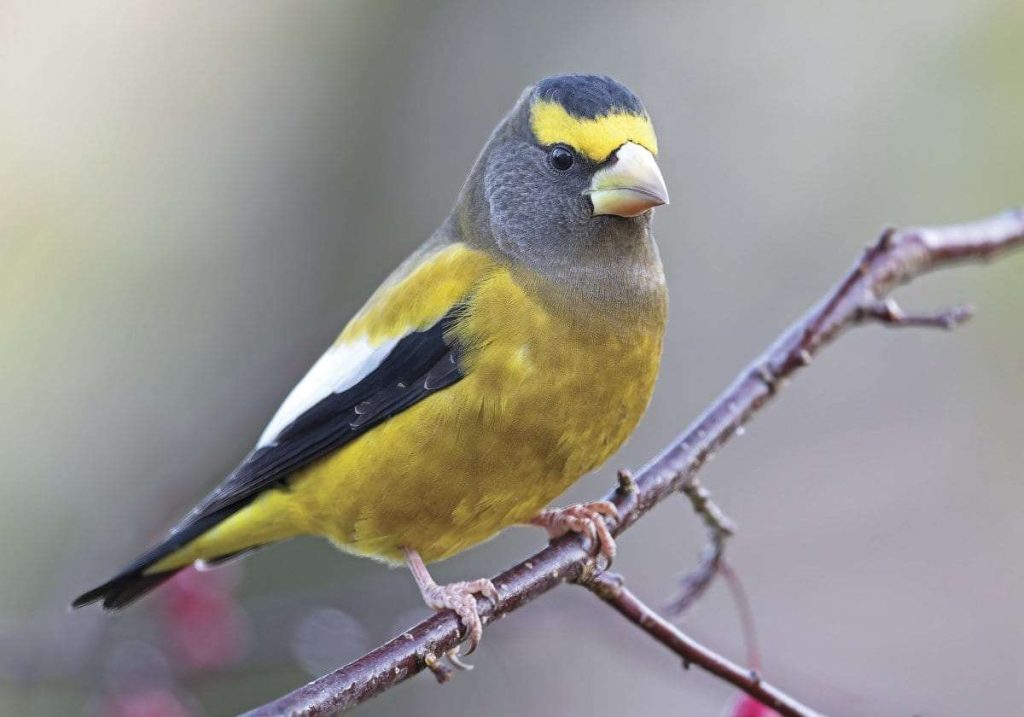
Evening Grosbeaks are considered vulnerable in Illinois, but they can be spotted during the winter season.
Evening Grosbeaks are robust birds with large bills and a striking yellow and black pattern. Adult males display a bright yellow stripe over their eyes, lending them a fierce appearance. Their heads are black, with gray necks, and their chests and bellies are yellow. Additionally, they possess white patches on their wings.
Females and juvenile males have greenish bills, primarily gray bodies, black and white wings, and a touch of yellow on their necks.
Scientific name: Coccothraustes vespertinus
Length: 6.3-8.7 inches (16-22 cm)
Weight: 1.37-3.04 ounces (38.7-86.1 g)
Wingspan: 12-14 inches (30-36 cm)
Evening Grosbeaks are residents of southern Canada, extending down the west coast to northern California. However, when cone crops are scarce, they migrate southward, reaching most US states.
These grosbeaks primarily inhabit forests and mountain regions. During winter, they are often attracted to backyard bird feeders, taking advantage of the easily accessible food supply.
Evening Grosbeaks naturally feed on flower buds during spring, insect larvae from treetops during summer, and shift their diet to seeds, berries, and small fruits during winter.
Fun Fact: Evening Grosbeaks possess such strong bills that they can crack open seeds that other smaller birds find challenging, often benefiting from the leftovers.
